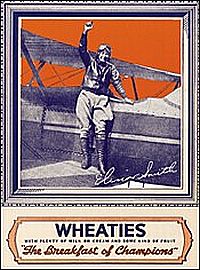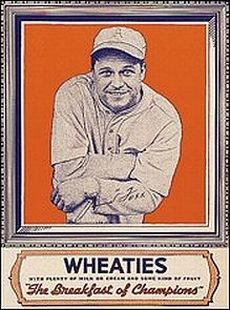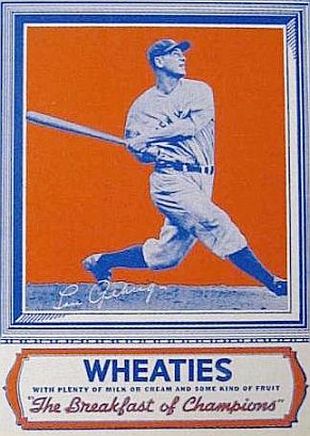
Lou Gehrig of the New York Yankees, first to appear on a "Wheaties" cereal package, back of box, 1934.
The fortuitous event occurred at a Minnesota company named Washburn Crosby, later known as General Mills. A wheat-flake cereal was soon fashioned and sold as “Washburn’s Gold Medal Whole Wheat Flakes.”
After a time, the cereal was more simply named Wheaties. Early on in Wheaties’ marketing, the cereal began an association with sports, and baseball in particular.
In 1927, Wheaties advertising appeared on a billboard at Nicollet Park, then home the Minneapolis Millers minor league baseball team. The first slogan for the cereal, credited to Minneapolis ad man, Knox Reeves, became: “Wheaties — The Breakfast of Champions.”
Wheaties’ marketing was soon bolstered by hiring professional sports stars to lend their names and likenesses for advertising campaigns. By 1934, the General Mills Company began including pictures of athletes on its Wheaties cereal boxes to help sell the cereal and establish Wheaties as a brand name. In 1934, the first sports figures to appear on the Wheaties cereal box were baseball stars — Lou Gehrig of the New York Yankees, as shown above, and Jimmie Fox of the Philadelphia Athletics, shown later below. They were followed that year by female aviator Elinor Smith and tennis star Ellsworth Vines. Initially, and for nearly the next twenty years, the athletes were depicted on the back of the Wheaties box or on its side panels. Athletes appearing on the front of the Wheaties box would not begin until the 1950s.
In the 1930s, the Wheaties athletes also pitched the product in radio “testimonials,” as product endorsements were then called, and also in magazine and other print ads. Radio in the 1930s was the primary media outlet and became the central focus of General Mills’ and Wheaties’ advertising — especially in connection with baseball. Wheaties-sponsored baseball broadcasts began from one radio station in Minneapolis, Minnesota, initially covering the minor league Minneapolis Millers on station WCCO. Wheaties radio sponsorship of baseball games soon expanded to 95 other radio stations and professional teams throughout the country.Wheaties found that its sales climbed through the 1930s, helped by its cereal-box endorsements as well as its radio and magazine ads. Wheaties had a range of sports stars appear in its endorsements, including: Jack Dempsey and Max Baer in boxing; Johnny Weismuller, the famous Olympic swimmer; Babe Didrikson, the female Olympic track and field star and later golf pro; football players Red Grange and Bronko Nagurski; and also pro golfers Sam Snead and Ben Hogan. Wheaties came to have such a strong presence in baseball that 46 of the 51 players selected for the 1939 All-Star Game had endorsed the cereal. But baseball became a mainstay of Wheaties in the 1930s and a key part of the “Breakfast of Champions” broadcast package. Among the endorsing stars through the 1930s were: Joe Cronin, Joe DiMaggio, Bob Feller, Lefty Grove, Carl Hubbell, Jimmie Foxx, Mel Ott, and Babe Ruth. Wheaties came to have such a strong presence in baseball that 46 of the 51 players selected for the 1939 Major League All-Star Game had endorsed Wheaties. On the breakfast table, Wheaties cereal boxes began including brief profiles of the athletes, showing them in action shots, or with short stories about them. Some offered cut out “cards” from the back of the package (see below). Others featured a famous player showing his pitching or batting technique. Mel Ott (1909 – 1958), for example, was shown offering bunting tips in one 1937 package illustration.
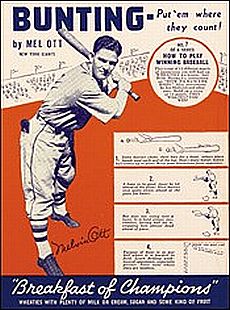 Mel Ott in 1937 offering a tutorial on the art of bunting on a Wheaties cereal back-of-box. |
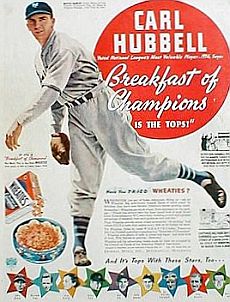 1937 Wheaties' magazine ad with Carl Hubbell’s endorsement. |
Ott was an outfielder who played his entire career with the New York Giants. At 5′ 9″and 170 lbs, Ott was a surprisingly powerful hitter who would accumulate some 511 home runs in his career. By 1937 when he appeared in Wheaties ads, he had been the National League home run leader in 1932, 1934, and 1936. In each of 1934, 1935 and 1936 he had more 100 runs batted in, compiling a batting average greater than .320 each year as well.
Mel Ott would become a twelve-time All Star in his career and play in three World Series. He is shown at right on the 1937 Wheaties package back panel offering tips on bunting.
In the Carl Hubbell Wheaties endorsement below that appeared in a 1937 Wheaties magazine ad, Hubbell, a pitcher for the New York Giants, is introduced as the National League’s Most Valuable Player in 1936. He is quoted as saying “Breakfast of Champions is the tops.” To the right of Hubbell’s head is a short paragraph in small print encouraging kids to collect the photos of the players shown in the advertisement. It reads: “Boys! Girls! Action Photos of Your Favorite Champions Now On Backs of Wheaties Packages. Start Your Set Now!” Below Hubbell is a paragraph encouraging the reader to try a bowl of Wheaties:
Have You Tried Wheaties?
“Wherever you are: at home, restaurant or dining car — ask for Wheaties. Big gold-brown toasted flakes of whole wheat! So delicious they have become America’s fastest growing cereal. Remember — Wheaties are whole wheat. Note statement on the package. ‘Wheat has always been the basic cereal food of most Americans. It furnishes over 50% more body building protein and a greater percentage of minerals and such grains as corn and rice.”
“Try Wheaties. Order by name W-h-e-a-t-i-e-s today. Tomorrow join Carl Hubbell and other Champions in a ‘Breakfast of Champions’– Wheaties with plenty of milk or cream and sugar — and some kind of fruit. With berries or peaches — Delicious!”
“Wheaties and the advertising claims made for them are accepted by the Council on Foods of the American Medical Association.”
At the bottom of the Carl Hubbell advertisement, along the margin, are small photos of nine other athletes, outlined in different colored stars, who by then had also endorsed “the breakfast of Champions.” These include: Lefty Grove, a pitcher for the Philadelphia Athletics and the Boston Red Sox; Jimmie Foxx, the famous hitter who also played with the Philadelphia Athletics and Boston Red Sox; Mel Ott of the New York Giants; Lefty Gomez, a pitcher with the New York Yankees, and others.
Jimmie Foxx had already appeared on the Wheaties package in 1934, as shown at right. In 1932, Foxx hit 58 homers and might well have broken Babe Ruth’s record that year but fell off a ladder at home and missed the last few games that season. In 1933, he took the American League Triple Crown with 48 homers, 163 RBI and .356 batting average.
|
“Lou Gehrig Says…” Lou Gehrig already had the distinction of being the first athlete to appear on a Wheaties box in 1934, as shown in the first photo at the beginning of this article. Gehrig won the Triple Crown batting title in 1934 with a .363 batting average, 49 home runs, and 165 RBIs. The next year, General Mills continued to use Gehrig in advertising. A full-page Wheaties magazine ad in 1935 has “The Iron Man of Baseball” extolling the virtues of the cereal along with his photograph and testimonial. In the ad, Gehrig is quoted as follows: 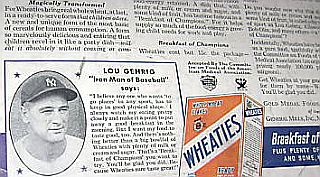 Portion of a larger 1935 "Wheaties" magazine ad featuring a testimonial from baseball great Lou Gehrig. “I believe any man who wants to go places in any sport has to keep in good physical shape. I always watch my eating pretty closely and make it a point to put away a good breakfast in the morning. But I want my food to taste good, too. And there’s nothing better than a big bowl of Wheaties with plenty of milk or cream and sugar. That’s a ‘Breakfast of Cham- pions’ you want to try. You’ll be glad you did. Because Wheaties sure taste great!” During his career, Lou Gehrig complied a number of impressive hitting feats, including, for example: 23 career grand slams; 73 three-run homers; and 166 two-run homers. Gehrig’s productive “men-on-base” home-run hitting gives him one of the highest average RBIs per homer among all-time leading home run hitters. |
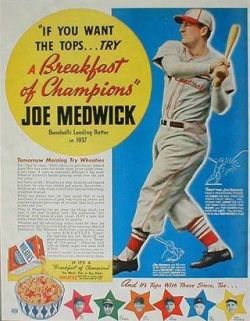
Joe Medwick, batting champ, 1937.
In 1937, Joe Medwick was shown on a Wheaties box, then billed as “Baseball’s Leading Batter.” Medwick (1911-1975) was an outfielder for the St. Louis Cardinals during the “Gashouse Gang” era of the 1930s. In 1937, he won the National League Triple Crown with 31 home runs, 154 RBIs, and a .374 batting average. He was also the National League’s Most Valuable Player that year. A ten-time All-Star, Medwick played for 17 years, finishing with a lifetime .324 batting average.
Like the Carl Hubbell Wheaties ad shown above earlier, the Medwick back-of-package ad on the Wheaties box at right includes his personal testimonial and also smaller photos of other endorsing players at the bottom of the ad. This group includes six other baseball stars: Joe DiMaggio of the New York Yankees, Mel Ott of the New York Giants, Bob Feller of the Cleveland Indians, Lefty Grove, by then with the Boston Red Sox, Hank Greenberg of the Detroit Tigers, and Carl Hubbell of the New York Giants.
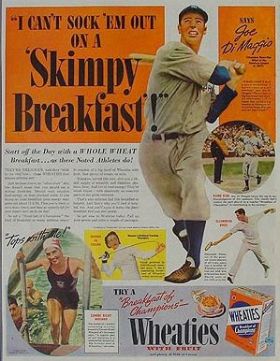
Baseball great Joe DiMaggio is featured in this 1938 Wheaties magazine ad, along with three other notable American athletes.
In 1938, Joe DiMaggio, then a hitting and fielding sensation with the New York Yankees, was also a Wheaties endorser. DiMaggio appeared on the backs of Wheaties boxes and also in at least two magazine advertisements, one by himself, and a second, shown at left, where three other Wheaties celebrity athletes shared the spotlight. This ad features “Joltin’ Joe” taking a full swing with his bat while extolling the virtues of a Wheaties breakfast.
DiMaggio made his major league debut with the New York Yankees on May 3, 1936, batting ahead of Lou Gehrig. The Yankees at the time had not been to the World Series since 1932. DiMaggio helped lead the Yankees to four consecutive World Series titles, 1936 through 1939. In the 1937 season, for example, DiMaggio hit 46 home runs, had 167 runs batted in, and had a batting average of .346. In all DiMaggio led the Yankees to nine titles in 13 years.
The Wheaties advertisement with DiMaggio at left also includes four smaller photos and one inset photo of Joe crossing home plate after hitting a home run. Also shown in this ad are tennis player Ellsworth Vines (1911-1994), and Olympic swimmer Lenore Kight Wingard (1911-2000). Wingard who won a silver medal in the 400 meter freestyle event at the 1932 Olympics and a bronze medal in the 400 meter freestyle event at the 1936 Olympics. The third athlete shown is Joanna de Tuscan (1908-2003), of fencing fame, also in the 1936 Olympics.
|
“Dutch” Reagan & Wheaties 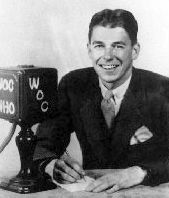 "Dutch" Reagan, radio man. 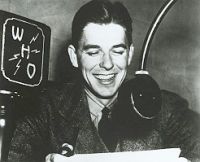 "Dutch" Reagan in action. |
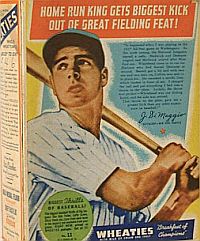
Wheaties “baseball card” cut-out on package back, late 1930s.
In the 1930s, Wheaties also issued a back-of-package design for cut-out baseball “cards.” Or more exactly, the backs of the Wheaties cereal boxes were the “cards.” The Wheaties box back panels often displayed a photo or artist’s rendering of the player, along with statistics and/or a short story about his play. These panels were intended to be hand cut from the boxes by youngsters. Some of the “cards” were issued as sets or in a series, the earliest dating to 1934-1935.
In 1938, Wheaties issued a sixteen-card “set” that is known to some collectors today as the “Biggest Thrill of Baseball” series — or the “Series 10” set. These cards are scarce today, and only a very few are found uncut from their original boxes. Shown at right is the Joe DiMaggio card, No. 11 in the series, and in this case, still un-cut from its box. This copy of the DiMaggio Wheaties “card,” according to Robert Edwards Auctions, sold for $580.00 sometime in 2005.
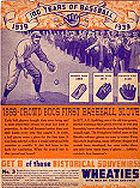
"100 Years of Baseball."
|
“Wheaties Champions” 1934 |
Wheaties also issued at least ten series of its baseball cards in the 1930s. And Wheaties not only featured baseball players in its 1930s marketing, but also other athletes, some of whom have already been mentioned — Elinor Smith, Ellsworth Vines, and Babe Didrikson. In addition to these, “Wheaties Champions” from other sports in the 1930s also included, for example, Kit Klein in speedskating, Bronko Nagurski in football, and Wilbur Chaw from auto racing.
The 1930s, of course, were only the beginning of General Mills marketing its Wheaties cereal brand with the help of sports celebrities. The practice would become much more sophisticated in the years ahead, as General Mills would continue to woo the world’s top athletes across all sports to help sell and burnish the Wheaties brand worldwide.
See also at this website “Athletes Advertising,” a topics page with descriptions and links to 14 stories of athletes endorsing or promoting various products, from Frank Gifford and Yogi Berra, to Pelé and Maradona. In addition, “Baseball Stories, 1900s-2000s,” another topics page at this website, includes links to 12 baseball-related stories. Other sports and/or marketing-related stories at this website include: “Baseball 1929 & Jimmie Foxx,” “Ruth at Oriole Park,” “Mickey Mantle’s 534th,” and “Keeps on Ticking,” the latter covering sports stars advertising Timex watches. Thanks for visiting — and if you like what you find here, please make a donation to help support the research and writing at this website. Thank you. — Jack Doyle
_______________________________
Date Posted: 29 March 2010
Last Update: 4 July 2019
Comments to: jackdoyle47@gmail.com
Article Citation:
Jack Doyle, “Wheaties & Sport, 1930s,”
PopHistoryDig.com, March 29, 20010.
_______________________________
Sources, Links & Additional Information
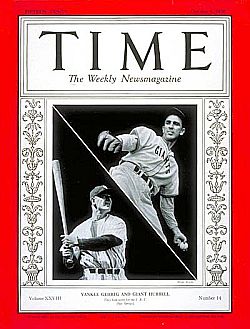
Time magazine cover of October 5, 1936 features Carl Hubbell, pitcher of the New York Giants, and Lou Gehrig of the New York Yankees. The two faced each other that year in the World Series. Gehrig had appeared on a Wheaties box in 1934, Hubbell in 1937.
“Wheaties: A Rather Humble Beginning,” Wheaties. com, 2010.
“General Mills History of Innovation: Wheaties — The Breakfast of Champions,” GeneralMills.com, 2010.
General Mills, Inc., Website, Wheaties.com, 2010.
“Wheaties,” Wikipedia.org.
Jim Rednour, “500HRC Members’ Long Tradition With the ‘Breakfast of Champions’,” 500HRC.com, Monday, 30 April 2007.
Sports Artifacts.com
“Mel Ott” and others (statistics), Baseball-Reference .com.
“Mel Ott” and others, Wikipedia.org.
Robert Edwards Auctions, Watchung, New Jersey.
“General Mills History of Innovation: Radio and TV,” GeneralMills.com.
